Retrogram #7725 – Actually, It’s All About Disappearances
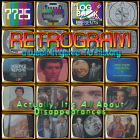 theLogBook.com releases the 26th episode of the Retrogram podcast, hosted by Earl Green, covering the following shows from the weeks of June 20th, 1977:
theLogBook.com releases the 26th episode of the Retrogram podcast, hosted by Earl Green, covering the following shows from the weeks of June 20th, 1977:
- TV movie: Science Report: Alternative 3
- TV movie: Man From Atlantis IV: The Disappearances
Star Trek: Music From The Video Games
 BSX Records releases a CD, Star Trek: Music From The Video Games, containing newly-arranged and performed music from many Star Trek video games and computer games from the 1990s onward.
BSX Records releases a CD, Star Trek: Music From The Video Games, containing newly-arranged and performed music from many Star Trek video games and computer games from the 1990s onward.
Doctor Who: Army Of Ghosts
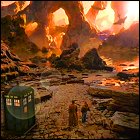 The 724th episode of Doctor Who (the 26th since the series’ revival) airs on BBC1. Tracy-Ann Oberman and Freema Agyeman guest star. This is the first part of the two-part season finale, and introduces the modern-day Torchwood Institute.
The 724th episode of Doctor Who (the 26th since the series’ revival) airs on BBC1. Tracy-Ann Oberman and Freema Agyeman guest star. This is the first part of the two-part season finale, and introduces the modern-day Torchwood Institute.
More about Doctor Who in the LogBook
Order VWORP!1 from theLogBook.com Store
Cassini arrives at Saturn
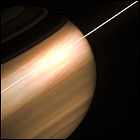 After a journey of seven years, gravity-assist slingshots past Earth, Venus and Jupiter, a plunge through Saturn’s ring-plane, and an engine burn of over an hour just to slow it down, the NASA/ESA space probe Cassini becomes the first man-made object to orbit Saturn. The trip has already paid off: Cassini has spotted never-before-seen features in Saturn’s immense rings, and succeeds in piercing Titan’s atmosphere with infrared imaging to provide one of the first-ever glimpses of the huge moon’s cloud-covered surface. Titan will also receive a visit from Cassini’s Huygens probe in 2005.
After a journey of seven years, gravity-assist slingshots past Earth, Venus and Jupiter, a plunge through Saturn’s ring-plane, and an engine burn of over an hour just to slow it down, the NASA/ESA space probe Cassini becomes the first man-made object to orbit Saturn. The trip has already paid off: Cassini has spotted never-before-seen features in Saturn’s immense rings, and succeeds in piercing Titan’s atmosphere with infrared imaging to provide one of the first-ever glimpses of the huge moon’s cloud-covered surface. Titan will also receive a visit from Cassini’s Huygens probe in 2005.
Star Trek: Voyager: The Farther Shore
![]() Pocket Books releases the second book in its post-TV revival of Star Trek: Voyager, “The Farther Shore” by Christie Golden.
Pocket Books releases the second book in its post-TV revival of Star Trek: Voyager, “The Farther Shore” by Christie Golden.
Witchblade: Static
 The 16th episode of Witchblade airs on cable channel TNT, based on the Top Cow comic book of the same name, starring Yancy Butler, David Chokachi and John Hensley. Tamara Gorski (Hercules: The Legendary Journeys, Poltergeist: The Legacy) guest stars.
The 16th episode of Witchblade airs on cable channel TNT, based on the Top Cow comic book of the same name, starring Yancy Butler, David Chokachi and John Hensley. Tamara Gorski (Hercules: The Legendary Journeys, Poltergeist: The Legacy) guest stars.
STS-94: do-over in space
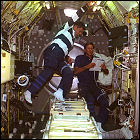 For the first and only time in the history of the American space program, a previously aborted mission is flown with the same vehicle, cargo and crew. Space Shuttle Columbia returns to orbit with Spacelab in its cargo bay for an attempt to fully carry out the aborted STS-83 mission, which was recalled to Earth in April. This time, the mission is successful, with nearly 16 days of microgravity experiments carried out by the crew. Flying Columbia – again – are Commander James Halsell, Pilot Susan Still, Payload Commander Janice Voss, mission specialists Donald Thomas and Michael Gernhardt, and payload specialists Roger Crouch and Greg Linteris.
For the first and only time in the history of the American space program, a previously aborted mission is flown with the same vehicle, cargo and crew. Space Shuttle Columbia returns to orbit with Spacelab in its cargo bay for an attempt to fully carry out the aborted STS-83 mission, which was recalled to Earth in April. This time, the mission is successful, with nearly 16 days of microgravity experiments carried out by the crew. Flying Columbia – again – are Commander James Halsell, Pilot Susan Still, Payload Commander Janice Voss, mission specialists Donald Thomas and Michael Gernhardt, and payload specialists Roger Crouch and Greg Linteris.
Babylon 5: To Dream In The City Of Sorrows
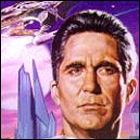 Dell Books releases the Babylon 5 novel “To Dream In The City Of Sorrows“, written by Kathryn M. Drennan (also writer of the first season B5 episode By Any Means Necessary). The book chronicles the life of Commander Sinclair following his departure from Babylon 5, his arrival on Minbar, and his eventual rise to the position of Entil’Zha – leader of the Rangers. The novel fills in many gaps left in Sinclair’s story on television, and is considered an official part of the show’s storyline.
Dell Books releases the Babylon 5 novel “To Dream In The City Of Sorrows“, written by Kathryn M. Drennan (also writer of the first season B5 episode By Any Means Necessary). The book chronicles the life of Commander Sinclair following his departure from Babylon 5, his arrival on Minbar, and his eventual rise to the position of Entil’Zha – leader of the Rangers. The novel fills in many gaps left in Sinclair’s story on television, and is considered an official part of the show’s storyline.
TekWar: Forget Me Not
 The 14th episode of the sci-fi crime series TekWar, based on William Shatner’s novel series, airs as part of the Universal Action Pack syndication package. Greg Evigan, William Shatner, and Maria del Mar (Mercy Point) star. With ratings low compared to the other Universal Action Pack offerings, the series is cancelled, with the remaining episodes scheduled to be “burned off” early the following year.
The 14th episode of the sci-fi crime series TekWar, based on William Shatner’s novel series, airs as part of the Universal Action Pack syndication package. Greg Evigan, William Shatner, and Maria del Mar (Mercy Point) star. With ratings low compared to the other Universal Action Pack offerings, the series is cancelled, with the remaining episodes scheduled to be “burned off” early the following year.
Deke! U.S. Manned Space From Mercury to the Shuttle
 Forge Books posthumously publishes astronaut Deke Slayton’s non-fictional memoir of his time in NASA, “Deke! U.S. Manned Space From Mercury to the Shuttle“, co-written with Michael Cassutt. The book details Slayton’s selection to the Mercury ground and his subsequent medical grounding, his time in charge of NASA’s astronaut office, and his eventual flight aboard the international Apollo-Soyuz Test Project mission.
Forge Books posthumously publishes astronaut Deke Slayton’s non-fictional memoir of his time in NASA, “Deke! U.S. Manned Space From Mercury to the Shuttle“, co-written with Michael Cassutt. The book details Slayton’s selection to the Mercury ground and his subsequent medical grounding, his time in charge of NASA’s astronaut office, and his eventual flight aboard the international Apollo-Soyuz Test Project mission.
Soyuz TM-19
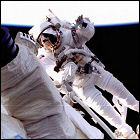 Soyuz TM-19 lifts off from Kazakhstan, on a mission to the Russian space station Mir with cosmonauts Yuri Malenchenko and Talgat Musabayev aboard. Over the course of their 125-day stay, the crew joins Dr. Valery Polyakov aboard Mir, in the middle of his record-shattering 437-day stay in space. Malenchenko and Musabayev conduct 11 hours worth of spacewalks to repair Mir’s exterior insulation and other minor maintenance, and returns home in November 1994 with German astronaut Ulf Merbold.
Soyuz TM-19 lifts off from Kazakhstan, on a mission to the Russian space station Mir with cosmonauts Yuri Malenchenko and Talgat Musabayev aboard. Over the course of their 125-day stay, the crew joins Dr. Valery Polyakov aboard Mir, in the middle of his record-shattering 437-day stay in space. Malenchenko and Musabayev conduct 11 hours worth of spacewalks to repair Mir’s exterior insulation and other minor maintenance, and returns home in November 1994 with German astronaut Ulf Merbold.
Soyuz TM-17
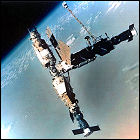 The Russian spacecraft Soyuz TM-17 lifts off from Kazakhstan, bound for space station Mir. Cosmonauts Vasili Tsibliyev, Aleksandr Serebrov replace the incumbent station crew, staying aboard Mir for 196 days, while Jean-Pierre Haigneré returns to Earth with the previous Mir crew aboard Soyuz TM-16 after a three-week stay. When the crew leaves Mir in January 1994, their departure is anything but routine, as Tsibliyev is unable to prevent a collision between Mir and the departing Soyuz.
The Russian spacecraft Soyuz TM-17 lifts off from Kazakhstan, bound for space station Mir. Cosmonauts Vasili Tsibliyev, Aleksandr Serebrov replace the incumbent station crew, staying aboard Mir for 196 days, while Jean-Pierre Haigneré returns to Earth with the previous Mir crew aboard Soyuz TM-16 after a three-week stay. When the crew leaves Mir in January 1994, their departure is anything but routine, as Tsibliyev is unable to prevent a collision between Mir and the departing Soyuz.
Donkey Kong 3
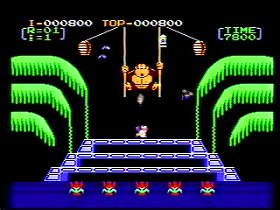 Nintendo releases the Donkey Kong 3 cartridge for the Nintendo Entertainment System, based on the company’s own 1983 arcade game.
Nintendo releases the Donkey Kong 3 cartridge for the Nintendo Entertainment System, based on the company’s own 1983 arcade game.
Activision class of ’81
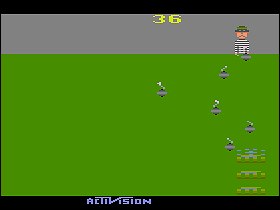 Activision releases a trio of cartridges for the Atari VCS home video game system: Kaboom!, Tennis and Laser Blast. Kaboom!, inspired by the ’70s arcade game Avalanche, proves to be the fast favorite of the three games.
Activision releases a trio of cartridges for the Atari VCS home video game system: Kaboom!, Tennis and Laser Blast. Kaboom!, inspired by the ’70s arcade game Avalanche, proves to be the fast favorite of the three games.
Astro Invader
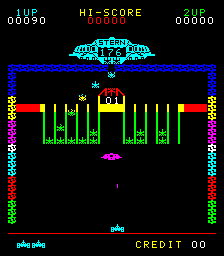 Chicago-based pinball manufacturer Stern makes one of its earliest forays into the booming video game industry with an altered version of the hit game Space Invaders, retitled Astro Invader. The game proves successful enough for Stern to invest in development of original games.
Chicago-based pinball manufacturer Stern makes one of its earliest forays into the booming video game industry with an altered version of the hit game Space Invaders, retitled Astro Invader. The game proves successful enough for Stern to invest in development of original games.
Doctor Who: The Evil Of The Daleks, Part 7
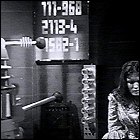 The 169th episode of Doctor Who airs on the BBC. This is the second Doctor’s second and final encounter with the Daleks, though it is the last Dalek story (and, barring a brief glimpse on a viewscreen in 1969’s The War Games, the last Dalek appearance) for the remainder of the 1960s. Dalek creator Terry Nation withdraws the BBC’s rights to use the Daleks in Doctor Who, intending to launch the Doctor’s enemies in their own series, possibly in America. The prospective Doctor-less Dalek series never comes to pass, and the Cybermen reign as the second Doctor’s most enduring recurring enemies as a result. The Daleks do not headline a Doctor Who story again for five years. This concludes the fourth season of Doctor Who, the show’s first post-regeneration season, and marks the end of producer Innes Lloyd’s tenure as showrunner. This episode is now missing from the BBC’s archives.
The 169th episode of Doctor Who airs on the BBC. This is the second Doctor’s second and final encounter with the Daleks, though it is the last Dalek story (and, barring a brief glimpse on a viewscreen in 1969’s The War Games, the last Dalek appearance) for the remainder of the 1960s. Dalek creator Terry Nation withdraws the BBC’s rights to use the Daleks in Doctor Who, intending to launch the Doctor’s enemies in their own series, possibly in America. The prospective Doctor-less Dalek series never comes to pass, and the Cybermen reign as the second Doctor’s most enduring recurring enemies as a result. The Daleks do not headline a Doctor Who story again for five years. This concludes the fourth season of Doctor Who, the show’s first post-regeneration season, and marks the end of producer Innes Lloyd’s tenure as showrunner. This episode is now missing from the BBC’s archives.
More about Doctor Who in the LogBook
Hear about it on the Sci-Fi 5 podcast
Order VWORP!1 from theLogBook.com Store
Twilight Zone: A World Of His Own
 The 36th episode of Rod Serling’s The Twilight Zone airs on CBS. Keenan Wynn stars in an episode written by Richard Matheson, closing the series’ first season.
The 36th episode of Rod Serling’s The Twilight Zone airs on CBS. Keenan Wynn stars in an episode written by Richard Matheson, closing the series’ first season.
This series is not yet fully chronicled in the LogBook. You could help change that.
More about The Twilight Zone in the LogBook and theLogBook.com Store
The Twilight Zone now streaming on Paramount Plus
Building Arecibo
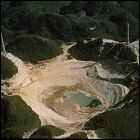 Proposed and designed by Cornell University, and funded by the Adavanced Research Projects Agency (ARPA), the Arecibo Ionospheric Research Center – a thousand-foot radar and radio telescope dish – begins construction in a natural limestone bowl south of Barrio Esparanza, Arecibo, Puerto Rico. Construction will take over three years, at a cost of nearly $10,000,000, with a steel feed receiver structure supported in mid-air over the parabolic dish by some five miles of steel cables. Facilities are constructed for scientists visiting the eventual facility, and additional facilities are constructed to shape aluminum into the mesh structure of the telescope dish on-site, a more economical approach than having those parts of the telescope shipped in from outside. Though conceived and pitched as a means of studying the ionosphere, with possible defense applications such as missile detection, the Arecibo facility will makes its best known contributions to astronomy after it opens.
Proposed and designed by Cornell University, and funded by the Adavanced Research Projects Agency (ARPA), the Arecibo Ionospheric Research Center – a thousand-foot radar and radio telescope dish – begins construction in a natural limestone bowl south of Barrio Esparanza, Arecibo, Puerto Rico. Construction will take over three years, at a cost of nearly $10,000,000, with a steel feed receiver structure supported in mid-air over the parabolic dish by some five miles of steel cables. Facilities are constructed for scientists visiting the eventual facility, and additional facilities are constructed to shape aluminum into the mesh structure of the telescope dish on-site, a more economical approach than having those parts of the telescope shipped in from outside. Though conceived and pitched as a means of studying the ionosphere, with possible defense applications such as missile detection, the Arecibo facility will makes its best known contributions to astronomy after it opens.
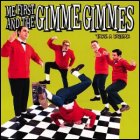 Punk parody supergroup
Punk parody supergroup